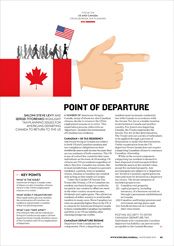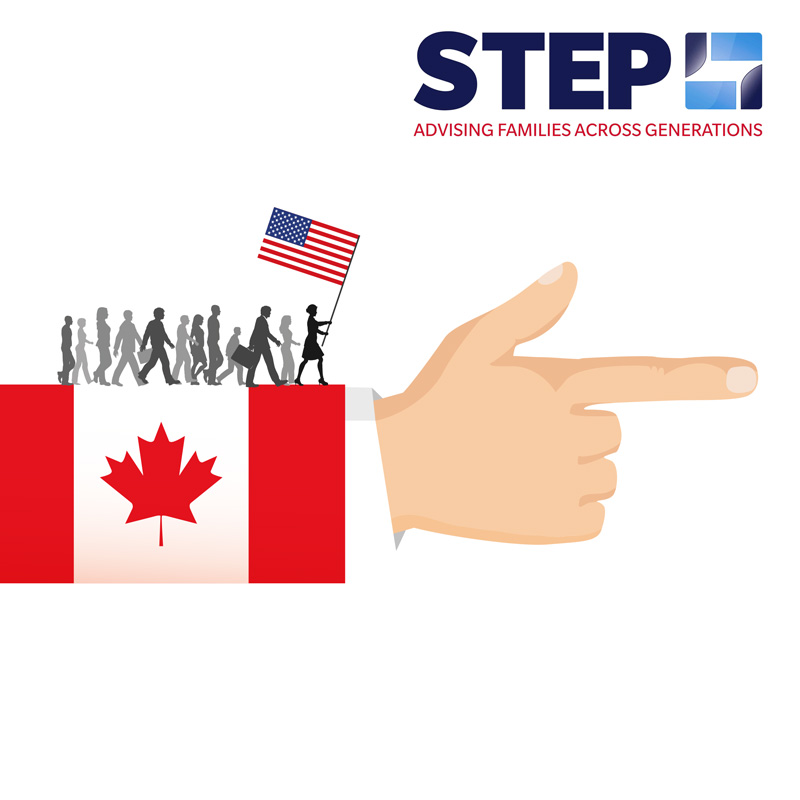We are thrilled to announce that Shlomi Steve Levy and Sergei Titorenko were invited to draft an article for the November 2019 edition of the Society of Trust and Estate Practitioners Journal (STEP Journal). Their article entitled “Point of Departure” identifies key tax planning issues for Americans living in Canada who return to the United States for employment reasons or for retirement. If you fall within this category of individuals, this article offers an insightful and accessible introduction to understanding these issues.
To read the article, you can see it below, or click here to download a PDF of the STEP Journal article: Shlomi Steve Levy and Sergei Titorenko, “Point of Departure”, STEP Journal, Vol. 27, Issue 9, pp. 45-47.
POINT OF DEPARTURE
Shlomi Steve Levy and Sergei Titorenko
STEP Journal, Vol. 27, Issue 9, pp. 45-47
November 2019
KEY POINTS
WHAT IS THE ISSUE?
Americans living in Canada, some of whom are also Canadian citizens, return to the US for employment reasons or to retire.
WHAT DOES IT MEAN FOR ME?
This expatriation process includes the termination of Canadian tax residency and presents a number of key tax-planning issues.
WHAT CAN I TAKE AWAY?
Practitioners who advise Americans living in Canada on any aspect of their departure from Canada should be aware of the Canadian and US tax implications of departure.
A NUMBER OF Americans living in Canada, many of whom are also Canadian citizens, decide to return to the US for employment reasons or to retire. This expatriation process, referred to as ‘departure’, includes the termination of Canadian tax residency.
CANADIAN v US TAX RESIDENCY
Americans living in Canada are subject to both US and Canadian taxation and tax-compliance obligations on their worldwide assets and income because they are tax residents of both countries. The US is one of a select few countries that taxes individuals on the basis of citizenship: US citizens are US tax residents regardless of where they live. Canada’s tax system, like in most jurisdictions, is based on a person’s residency: a person, even a Canadian citizen, remains a Canadian tax resident only as long as they reside in Canada. Under the Canada-US Income Tax Treaty (the Treaty), a US or Canadian tax resident can claim foreign tax credits for tax paid in one country to offset tax owed in the other country on most income, dividends and capital gains. This allows tax residents of either country to avoid double taxation in many cases. Since Canadian tax rates are generally higher than in the US, it is common for Americans living in Canada to have considerable Canadian tax liability and little or no US tax liability after claiming foreign tax credits.
CANADIAN DEPARTURE REGIME
Departure from Canada has two (2) components. In the first component, a departing tax resident must terminate residential ties with Canada in accordance with the Income Tax Act or a double taxation treaty between Canada and another country. For Americans departing Canada, the Canada-US Tax Treaty supersedes the Income Tax Act in this determination. This Treaty sets out a series of tiebreakers to be applied through a process of elimination to make this determination. Unlike expatriation from the United States, departure from Canada does not require a departing Canadian citizen to renounce Canadian citizenship.
While in the second component, a departing tax resident is deemed to have disposed of and reacquired his or her worldwide assets at their fair market value except for excluded property. Any accrued gains are subject to “departure tax” levied at Canadian capital gains tax rates and must be declared in a departure tax return. The broad categories of excluded property are:
- Canadian real property,
- capital property, including inventory, of a business carried on through a permanent establishment in Canada,
- Canadian and foreign pensions and retirement savings plans, and
- beneficial interest in Canadian inter vivos trusts.
POSTING SECURITY TO DEFER CANADIAN DEPARTURE TAX
Individuals with considerable Canadian departure tax liability can post security acceptable to the Canada Revenue Agency (CRA) to defer Canadian departure tax instead of paying this liability. The CRA accepts the collateral posted as security on a case by case basis, but the most common forms are cash, Government of Canada bonds, a letter of credit guaranteed by a Canadian financial institution, Canadian real estate, and shares in a Canadian corporation. The posted security must cover the entire Canadian departure tax liability. If the CRA accepts the posted security, the CRA will not charge interest or penalties between departure and the date an asset subject to Canadian departure tax is sold.
While security is posted, it is subject to annual review by the CRA. If a departing taxpayer posts security and subsequently resumes Canadian tax residency, the taxpayer can unwind departure without paying departure tax and discharge the security. The taxpayer is effectively treated as if he or she had never departed Canada.
ELECTION TO BUMP UP THE COST BASIS OF ASSETS
When an individual departs Canada, the cost basis of assets subject to Canadian departure tax is bumped up to their fair market value. Under Article XIII, Paragraph 7 of the Canada-US Tax Treaty, a departing taxpayer can also elect to bump up the cost basis of these assets for US tax purposes. For Americans living in Canada, a Treaty bump-up election will result in a deemed disposition of the assets for US tax purposes and US capital gains tax will be owed on the deemed capital gain. The Canadian departure tax can be used as a foreign tax credit to offset the US tax.
However, there are three limitations on foreign tax credits for a Treaty bump-up election claimed by an American departing Canada. First, this election can trigger the imposition of the US Net Investment Income Tax (NIIT) and Canadian departure tax cannot be applied as a foreign tax credit against this tax. The NIIT is a 3.8% tax which is levied against most capital gains earned by Americans who earn worldwide income beyond a given threshold which depends on if tax returns are filed as married couples or as single filers. A departing American could therefore be pay both Canadian departure tax and NIIT on a Treaty bump-up election.
Second, Canadian departure tax may not be sufficient to offset US capital gains tax triggered by a Treaty bump-up election on assets that have appreciated in value which departing Americans owned upon assuming Canadian residency and that they continue to own on departure. The cost basis of such assets for US tax purposes would be smaller than their cost basis for Canadian tax purposes because the latter would have been their fair market value upon assuming Canadian residency. The capital gain for US tax purposes would be greater than the capital gain for Canadian tax purposes, which could result in the US capital gains tax being greater than the Canadian departure tax depending on applicable US and Canadian capital gains tax rates.
Third, a Treaty bump-up election on a Canadian principal residence by an American departing Canada will trigger US capital gains tax with no available Canadian departure tax to offset it. If an American departing Canada elects a Treaty bump-up election of the value of a principal residence, no Canadian tax will be owed through the application of the Canadian Principal Residence Exemption which exempts the disposition from tax regardless of the value of the capital gain. However, the departing American will only be entitled to a US capital gains exemption of $250,000 USD (or $500,000 USD for married couples filing jointly). Should US tax be owed after applying this latter exemption, no foreign tax credits are available to offset this tax because no Canadian departure tax was owed on the deemed disposition.
TAX SAVINGS FOLLOWING DEPARTURE
For individuals who depart Canada for the United States, other than typically enjoying better weather, they frequently have an incentive to terminate Canadian tax residency because they will realize tax savings by being solely subject to US taxation. The tax savings will depend on an individual’s annual income and if the individual moves to a State with higher personal income tax rates such as New York or California or to a State with no personal income tax such as Florida or Texas. The incentive to terminate Canadian tax residency may be less interesting for a departing taxpayer who has considerable Canadian departure tax liability and who may need a considerable number of years to recoup the Canadian liability with tax savings.
POST-DEPARTURE TAX ISSUES
There are a number of post-departure tax issues for Americans who depart Canada in respect to their Canadian assets. Following departure from Canada, a number of withholding obligations will apply to Canadian income, namely:
-
- dividends from Canadian corporations to a US shareholder will be subject to a 15% dividend withholding, which can be reduced to 5% in certain instances,
- rental income from Canadian real estate, and
- withdrawals from Canadian registered retirement accounts (RRSPs, RRIFs, etc.). In the case of registered retirement accounts, the Canada-US Tax Treaty allows for mechanisms to make substantial periodic withdrawals without incurring massive penalties.
Another concern for Americans departing Canada is the sale of a Canadian principal residence following departure. While they are Canadian residents, they can claim the Canadian Principal Residence Exemption to exempt the sale from Canadian tax, but will be subject to US capital gains tax on the sale. Following departure, the Canadian Principal Residence Exemption remains available for the sale of a property which served as a Canadian principal residence, but the portion of the available exemption will decrease based on the number of years since the seller’s departure from Canada.
CONCLUSION
Practitioners who advise Americans living in Canada on any aspect of their departure from Canada should be aware of the Canadian and US tax implications of departure. Here are a few takeaways:
-
-
- Canadian departure tax may be sufficiently high that it outweights possible tax savings. In such case, a American considering departure from Canada may do one of the following rather than pay the tax: (i) post security to defer the tax or (ii) not depart Canada.
- Treaty bump-up elections for departing Americans are potentially subject to greater tax than other categories of persons who depart Canada due to the application of US tax on these elections.
- After departure, Americans who maintain Canadian situs assets remain subject to a number of post-departure Canadian tax issues which should be evaluated prior to departure.
-


The comments offered in this article are meant to be general in nature and are not intended to provide legal advice regarding any individual situation. Before taking any action involving your individual situation, you should seek legal advice to ensure it is appropriate for your circumstances.
About the author
Shlomi Steve Levy is a Partner of Levy Salis LLP and is a member of the Quebec Bar, the Law Society of Ontario (L3), the Society of Trust and Estate Practitioners, and the Canadian Bar Association.



